Waiting for the Worst to Pass
With broader economic uncertainty looming, the outlook for the multifamily sector is decidedly mixed.
By Beth Mattson-Teig
Thursday, November 12, 2020
View external article
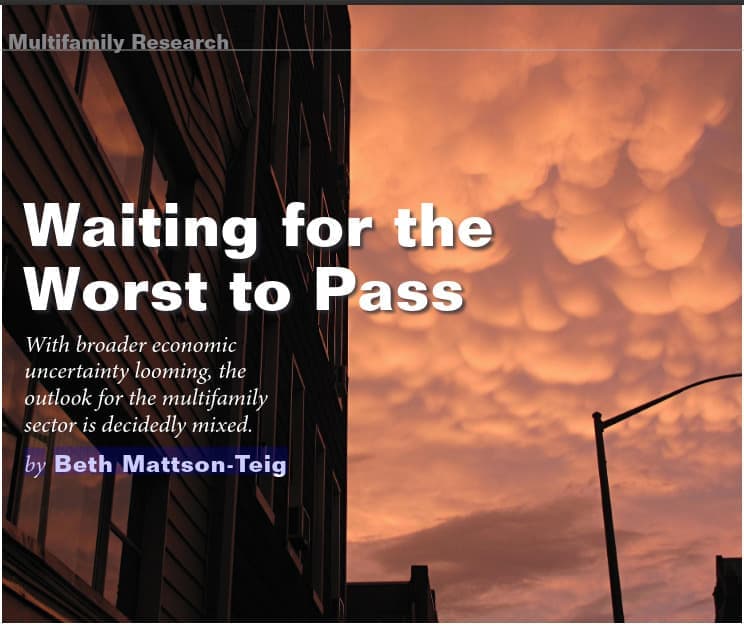
Exclusive research results from NREI’s seventh annual multifamily survey show that industry participants have dialed back expectations on performance and access to capital. Yet they continue to view multifamily favorably relative to other property types.
“People generally view multifamily as being more resilient, and that is playing out in the data as well,” says Mike Sebastian, industry principal, investment management at commercial real estate software firm AppFolio Inc.
Multifamily fundamentals have been holding up better than those in other property sectors that have been more greatly impacted by the negative effects of the coronavirus and subsequent economic downturn. According to Moody’s Analytics REIS, apartment vacancies remained unchanged in the second quarter at a relatively tight 4.8 percent, while effective rents declined by only 0.4 percent.
The nearterm outlook for the decline in rents by 2.1 percent, which is the first forecast of negative rent growth in the survey’s history. No escape from the effects of the pandemics part of this year’s survey, NREI included a series of questions to gauge the effects of the COVID-19 pandemic and what multifamily stakeholders think needs to be done to help support renters going forward. Survey results show a mean 88 percent of rents were collected from April through June, with respondents forecasting they will collect 89 percent of rents from July through December. Notably, those figures are lower than the results from the National Multifamily Housing Council’s (NMHC) Rent Payment Tracker, which has monitored monthly rent collections at more than 11 million apartment units at professionally managed properties across the country.multifamily sector is also muddy. Respondents’ views are mixed on what will happen with occupancies and rents in the coming year. Nearly half of respondents (47 percent) think occupancies will improve over the next 12 months and an equal amount expect a decline, while 6 percent believe there could be no change. That is a notable shift compared to surveys over the past six years in which a majority of respondents consistently predicted that occupancies would either maintain current levels or continue to improve.
Opinions are similar on the outlook for rents. In all, 45 percent of respondents anticipate that rents will climb, while 40 percent think they will fall, and 15 percent expect no change. That also reflects a significant drop compared to previous surveys where the vast majority of respondents—upwards of 66 percent— expected rates to increase in the coming year. The increased pessimism translates to a projected overall average decline in rents by 2.1 percent, which is the first forecast of negative rent growth in the survey’s history.
No escape from the effects of the pandemic
As part of this year’s survey, NREI included a series of questions to gauge the effects of the COVID-19 pandemic and what multifamily stakeholders think needs to be done to help support renters going forward.
Survey results show a mean 88 percent of rents were collected from April through June, with respondents forecasting they will collect 89 percent of rents from July through December. Notably, those figures are lower than the results from the National Multifamily Housing Council’s (NMHC) Rent Payment Tracker, which has monitored monthly rent collections at more than 11 million apartment units at professionally managed properties across the country.
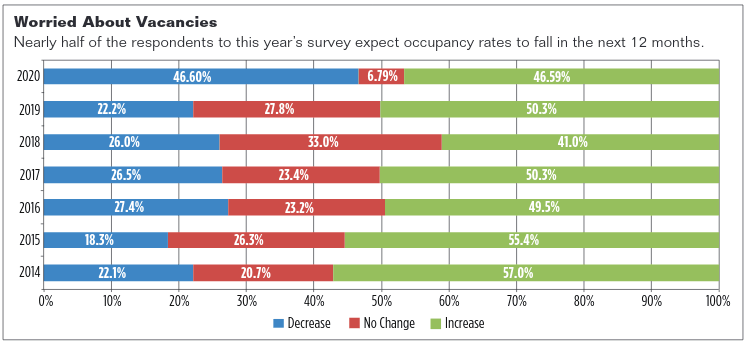
According to NMHC’s figures, owners at those properties collected between 94.6 percent and 95.7 percent of rents in the months of April, May, June and July. For the most recent month, NMHC’s tracker showed that 90.0 percent of rents had been collected as of August 20.
Still, given the overall level of national unemployment that has resulted from the COVID-19 economic shock, observers initially expected a worse hit for apartments. Even at 88 percent, the level of rent collection is far higher than, for example, what retail owners have been able to collect in recent months.
The CARES Act that Congress enacted and President Trump signed into law in late March softened the blow and enabled many renters to stay current. The act allowed unemployed workers that previously would not have qualified (including freelancers and gig workers) to collect state and federal benefits. In addition, the $600 per week in extended unemployment insurance from the federal government was an effective salve. Those payments expired at the end of July, however.
President Trump signed a memorandum in early August to allow for Federal Emergency Management Agency funds to be used for $300 weekly payments for a limited time. As of August 27, most states were in the process of applying for those funds, although experts estimate they will only cover up to five weeks of payments before the money is exhausted. So ultimately it will be up to Congress to implement anything for the longer term.
The relative strength of the sector is reflected in respondents’ rankings of outlooks by property type.
On a scale of 1 to 10, multifamily tied with industrial as the most attractive for current investment with a mean score of 7.3. Data centers and single-family rentals followed closely at 6.9, while self-storage and medical office also rated high at 6.3. Those sectors that are viewed less favorably include seniors housing at 5.8, student housing at 4.6, office at 4.1, retail at 3.3 and hotels at 3.2.
Results show that the attractiveness ratings have dropped for each property type in the wake of the pandemic, and multifamily is no exception. Although still a top-rated sector, views of multifamily are more tempered compared to survey results for each of the last six years, when mean scores ranged between 7.7 and 8.0.
“For now, multifamily is holding up relatively well. The interesting question is what happens moving forward,” says Ryan Severino, CFA, chief economist at JLL. “The longer they do without a replacement and the lower the amount approved assuming a package gets approved the more that could jeopardize the ability of tenants to pay rent, especially in lower quality apartments.
”An overwhelming majority of respondents (82 percent) said that at least a portion of tenants had requested rent relief. However, most (61 percent) said that less than one quarter of tenants had requested some form of relief. Among respondents who had received rent relief requests, 87 percent had granted at least some level of relief.
When asked which governmental measures respondents would support going forward as most beneficial for the multifamily sector, extending the duration of unemployment benefits rated the highest at 62 percent, followed by extending the amount of money people can collect in unemployment benefits at 47 percent and forbearance periods at 38 percent. Those programs that rated less favorably included Federal Reserve-backed measures at 29 percent, eviction moratoriums at 18 percent and rent freezes at 13 percent.
“Any government unemployment help is best,” agrees Barbara Byrne Denham, senior economist at Moody’s Analytics REIS. Even in metros where cases are declining, as they are in many parts of the U.S., they remain vulnerable to setbacks if the reopening moves too quickly, she says. Businesses that are not open, or not operating at full capacity, continue to weigh on unemployment. For example, July employment for the leisure and hospitality was still down 26 percent compared to February, which represents 4.3 million lost jobs. “These employees need government help to pay their rent and mortgage,” she says.
There is still a lot of uncertainty around what is going to happen to fundamentals if the programs are not renewed.
“I would expect to see a dip in rent payments, but not in occupancy,” says Sebastian. One exception where there are likely to be bigger declines in occupancies over the next 12 months is in major cities. “I think you’re going to see some situations, such as New York City, where occupancies are going to decline and stay depressed for a while,” says Sebastian.

Opinions are split on fundamentals
The overall uncertainty about the path of the outbreak and the continued development of treatments and vaccines, the extent of government relief efforts and the shape and length of the economic recovery are reflected in respondents’ views on the outlook for multifamily fundamentals.
“As I keep reminding people, the pandemic is the recession,” Severino says. “They are not independent. But the amount of fiscal stimulus will also matter with so many people still unemployed and slower job gains likely ahead.”
The variance also is likely a reflection of how individual markets and even individual properties have been impacted differently during COVID-19.
“Vacancies will continue to rise in most metros and rents will decline, but it will vary widely by metro,” Denham says. The high-priced markets, such as New York City and Los Angeles, are likely to see the greatest distress due to people now working remotely from other locations that have moved or opted not to renew their lease. “We also caution that many of the anecdotal stories of people fleeing the urban areas are greatly exaggerated,” she adds.
Although REIS is predicting that the multifamily sector will see less distress than other income-producing property types, it does have a negative forecast ahead that calls for vacancies to rise to the mid-6 percent range later this year and peaking at or close to 7 percent in early to mid-2021. Effective rents for 2020 also could decline by a record high of 3.9 percent.
Outlook may vary by quality of assets. In this year’s survey NREI added a question asking respondents to gauge outlook for class-A, class-B and class-C assets separately. The results were interesting, showing that class-A had the highest collective answers for “excellent” and “very good” at 45.9 percent vs. 35.8 percent for class-B and 26.3 percent for class-C. But when broadened to “good”, class-B pushes to the top. In all, only 19.4 percent said the outlook for class-B was “fair” or “poor” compared with 26.6 percent for class-A and 46.6 percent for class-C.
Geographically, pre-COVID-19 data was showing large outflows of tenants from high tax states, such as New York and California. In the West and Pacific Northwest, people were moving west into Arizona, Nevada, Idaho and parts of Texas. In some cases, such as New York City, the pandemic has accelerated some of those outflows. “It’s a long-term trend, partly because of the tax structures in the states that people were leaving,” says Sebastian.
Respondents view the South/Southeast/Southwest and West/Mountain/Pacific as the two strongest regions for performance. On a scale of 1 to 10, each rated a mean score of 7.5. That does show a slight dip in confidence compared to a year ago, when the South rated 7.8 and West rated 7.7. Respondents remained fairly consistent on their views of the East and Midwest at 7.2 and 6.5 respectively.
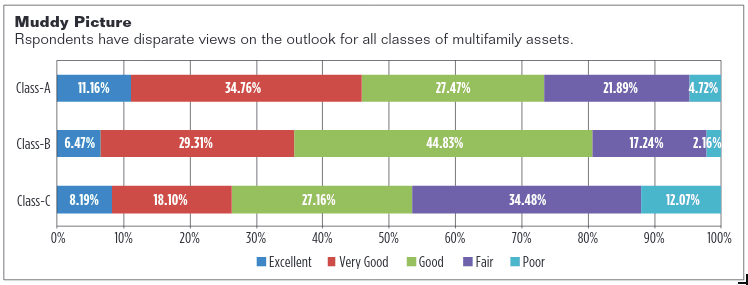
Investors still on the sidelines
Market uncertainty has taken a toll on investment sales. Transaction volume dropped sharply in second quarter with $13.9 billion in apartment sales that was down 70 percent compared to the prior year, according to Real Capital Analytics.
“When this whole pandemic happened, a lot of people just stopped in their tracks. They weren’t looking to buy, or sell or do anything,” says Warren Berzack, a national director with the multifamily advisory group at broker-age firm Lee & Associates. “There is still a large segment of the buyer pool that is still on the sidelines, but then you have a decent segment of the market that is back in the market looking.” Financing is still available, and borrowers are seeing that they can still get financing at attractive rates, he adds.
When asked about their plans for multifamily assets over the next 12 months, nearly half of respondents (54 percent) expect to hold, while 37 percent plan to buy and a minority 9 percent intend to sell assets. Comparing that sentiment to past surveys reveals some interesting trends. Although the number of respondents who plan to hold is up from 47 percent in the 2019 survey —and the biggest percentage in the seven-year history of the survey— the 37 percent who said they intend to buy apartments in the coming year remains unchanged compared to 2019.
“My take is that investors would prefer not to sell due to an exogenous event,” says Severino. If they owned assets they believed in, they’d rather not be forced to sell. Moreover, the underlying thesis behind owning multifamily assets —namely strong demand and undersupply or limited supply— remains intact, he says. “That will continue to be true once we move past the pandemic. That does not mean that all markets and all subtypes will perform the same, but most investors are smart enough to see through the pandemic to the long-term thesis,” he adds.
Market uncertainty is also pushing investment managers and sponsors to increase communication with investors and stakeholders. Companies are focused on being highly transparent with their investors and providing news on COVID-19 response plans, market information and updates on asset-level and portfolio performance. When asked how respondents are communicating multifamily asset performance to investors, a majority favor email (66 percent) or one-on-one phone conversations (53 percent). Additionally, 26 percent use video calls and 16 percent rely on investor portals.
Respondents expect uptick in distress
Capital is lining up for distressed assets, and many buyers are also hoping for some pricing adjustments in their favor.
The vast majority of respondents (88 percent) anticipate that loan delinquency rates in the multifamily sector will rise compared to 10 percent who predict no change and 2 percent who think delinquencies could fall. Overall, the average expectation is an increase of 4.5 percent in delinquency rates.
“There are certainly those investors who are hitting pause and are very nervous,” says Sebastian. “At the same time, in the other camp are those people who are getting ready for huge market opportunities.”
The unfortunate side effects of this are going to be business plans that fail, foreclosures and properties that have to be sold at a discount. Although that hasn’t started happening yet, and it probably won’t until early next year, there are a lot of investors that are getting ready to take advantage of those situations, he says.
One group planning to be an active buyer in the coming year is Dalzell Capital.
“We are definitely looking to grow our portfolio, but our growth trajectory and business plan has changed, because the opportunities in front of us are going to be extremely different than the opportunities that we created over the past few years,” says Christian Dalzell, managing partner at Dalzell Capital. The former Starwood Capital Group exec founded Dalzell Capital in 2017 and has since acquired nine properties in Philadelphia that include 300 apartment units and 15,000 square feet of commercial space.
Although the firm is actively looking for buying opportunities, the company hasn’t closed on any new deals since its last acquisition in December.
“Investors are just not going to buy anything unless they feel like they are being properly compensated,” says Dalzell. “I’m not sure what properly compensated means today, but I know that it means more than they have been paid over the last few years.”
Once sellers get their arms around that and there is some reduced pricing, that’s when trades will resume. However, that is not likely to happen in earnest in multifamily until early 2021, he adds.
A majority of respondents (63 percent) expect cap rates to increase over the next 12 months compared to 28 percent who predict a decrease and 9 percent who think cap rates will remain the same. The fact that respondents are anticipating an increase in cap rates is not surprising, as a majority have been anticipating an increase for the past three years. However, the reasons for that expected increase are likely very different. It is also interesting to note that 28 percent of respondents predict that cap rates could decrease, which is the highest level in the seven-year history of the survey. Conventional wisdom says that with less tenant demand and rent growth dropping, cap rates should rise.
“You are starting to see that a little bit, but the pushback is the low interest rates,” says Berzack. Borrowers can get a 10-year interest only loan from Fannie Mae at between 3 and 3.5 percent, depending on the quality and location of the property. “That’s allowing people to pay really aggressive numbers. So, things are not affecting pricing as much as one would think,” he says. Cap rates are moved a little higher, but not significantly, he adds. Overall, survey respondents predict a slight increase in cap rates over the next 12 months at an average of 20 basis points.
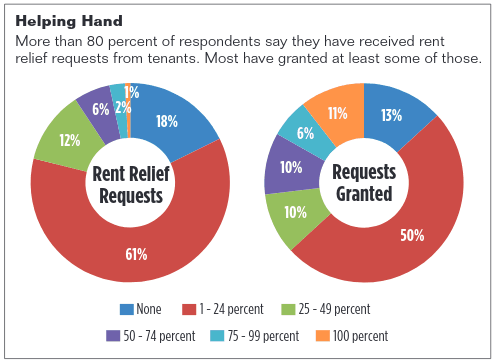
Access to capital tightens
Nearly half of respondents say both equity and debt are less available for multifamily properties than it was 12 months ago. In all, 46.2 percent of respondents believe equity is less available, 29.1 percent say it is unchanged and 18.0 percent said it is more available. In addition, 7 percent were unsure. On the debt side, 55.7 percent said financing is less available, 26.0 percent believe it unchanged, 14.0 percent said it is more available and 4 percent were unsure.
Although capital may be less available, there continues to be good liquidity in the market from a variety of different capital sources. “I don’t see the availability of capital constricting from a big picture standpoint, although there are some geographic areas where some of the fundamentals face a little more headwind than others,” says Jeff Erxleben, executive vice president and regional managing director at NorthMarq in Dallas. For example, some coastal markets that experienced off the chart rent growth in recent years could very well see some erosion of rents, he says.
Respondents continue to believe there is ample capital available from a variety of different sources, with Fannie Mae/Freddie Mac being the most prevalent with a mean score of 6.7 out of 10, followed by local/regional banks at 6.3 and national banks at 6.2. It is notable that respondents said that capital is slightly less available from each lender source than in past surveys. Those that saw the biggest drops were pension funds and REITs, each rated a 6 in the 2019 survey and have now fallen to 5.2 and 5.1 respectively.
Fannie and Freddie remain the primary financing sources for borrowers. Their purpose is to provide liquidity to the housing market during up and down market cycles, and they have been living up to that in the current downturn with consistent financing throughout 2020. “They definitely took a harder look at certain aspects of the multifamily market as we have gone through this pandemic, but they remain the go to lenders,” says Erxleben. Life insurance companies continue to have a favorable outlook on multifamily, although different participants did take a pause at certain points over the past few months. “Although multifamily is a top asset class that they want to invest in, they are definitely picking their selective spots. When they find those opportunities they want to pursue, they are very aggressive about getting that money out,” says Erxleben. The one category of lender that has shrunk is bridge lenders due to capitalization issues.
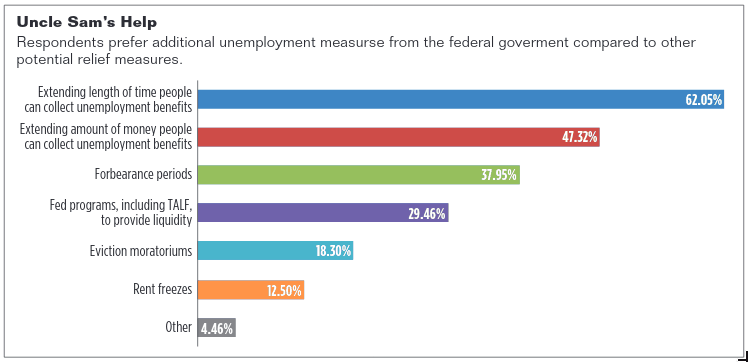
Debt service coverage ratios (DSCRs) have continued to tighten on the refinance side, in large part because of the liquidity that Fannie and Freddie provide. For example, a cash-out refinance at the beginning of the pandemic was challenging to get done. Today, the DSCR requirement is at 1.25x on a very good quality loan, notes Erxleben. Larger up-front reserve requirements are playing a significant role in that lender appetite. However, those low DSCR levels are also a reflection of the confidence that lenders have in the fundamentals and competition that remains in the market, particularly for good quality loans.
Half of respondents expect increased risk premiums (54 percent) and debt service coverage ratios (49 percent) over the next 12 months, and stable interest rates (58 percent).
“Overall lender appetite for multifamily is still strong and a favored asset class compared to other sectors,” says Erxleben. The refinance market in particular has remained strong and in fact represents a large percentage of the mortgage origination business in 2020. The acquisition market has been building steam again heading into August. Meanwhile, new construction lending is more mercurial in that it is more geography driven, he adds.
Respondents reported mixed views on the level of development in the multifamily sector. Overall, 36 percent believe it is the right amount, 27 percent think it is too much, and 24 percent said it is too little. Those views are consistent with the 2019 survey, where 38 percent said it was the right amount; 35 percent said too much, 16 percent too little and 10 percent were unsure. According to RentCafé, construction has dropped 12 percent this year, with 283,000 new units expected to be delivered in 2020. Even so, some pockets of oversupply are inevitable. Dallas-Fort Worth, for example, is leading the nation in terms of apartment construction with 19,300 new units scheduled for completion this year.
Despite some of the near-term uncertainty, multifamily developers and investors appear to be looking beyond COVID-19 to the longer term demand drivers for rental housing. “Multifamily has traditionally been a good investment over the last several years, and it will continue to be a good investment for the foreseeable future, especially as we see the younger generations move into the rental space,” notes Sebastian.
Survey methodology: The NREI research report on the multifamily sector was conducted via an online survey distributed to NREI readers in August. The 2020 survey results are based on responses from 237 participants. The majority of respondents hold top positions at their firms, with 56 percent who said they were either an owner or C-suite executive. Respondents also represent a cross-section of different roles in the multifamily sector, including private investors (37 percent), developers (16 percent) and financial intermediaries (12 percent).

